Heading to the Balkans? Don’t miss the best Sofia attractions! Use our top 10 list of things to do in Sofia Bulgaria and get acquainted with a fascinating city.
When we planned our time in the Balkans, locations other than Sofia, and Bulgaria in general, took center stage. But then we visited the capital of Bulgaria. In the space of a few days, we encountered a host of Sofia attractions which convey the city’s rich heritage spanning more than two thousand years. We took to Sofia immediately. The Bulgarian capital city’s vibe is plucky, progressive, stylish, and steeped in layers of history. We had to share our experiences with a list of things to do in Sofia Bulgaria in this blog post.
This article contains affiliate links and/or references to our advertisers. We may receive compensation when you click on or make a purchase using these links.
Table of Contents
Bulgarian History Background
Sofia has been a settlement since at least 4 centuries before the time of Christ. Briefly occupied by Philip of Macedon and his son, Alexander the Great, in the 4th century B.C., the city then called Serdica was conquered by the Romans around 29 B.C. As an administrative center for the Roman Empire, Serdica was walled and civic buildings such as public baths, a basilica, and an amphitheater were built.

When the Emperor Diocletian (see our write-up on his retirement palace in Split, Croatia) divided its province into two, Serdica became one of the new capitals. In 311, the year of Diocletian’s death, Emperor Galerius delivered the Edict of Toleration in Serdica, which effectively ended Christian persecution begun by his predecessor. This legalized Christianity throughout the Empire.
Emperor Constantine the Great referred to Serdica as “his Rome.” Byzantine Emperor Justinian rebuilt Serdica after it was destroyed by the Huns, and it was rebuilt after Slav incursions until 809, when it became part of the First Bulgarian Empire. In the next couple hundred years, control over the city went back and forth between Bulgarians, Magyars, and Byzantines.
In 1376, the city was renamed Sofia, became a center for goldsmithing and other craftsmanship, and was conquered by the Ottoman Empire six years later. Its diverse population grew to over 20,000 inhabitants during the Ottoman occupation, consisting of Bulgarians, Ashkenazi and Sephardic Jews, Turks and Roma. Liberated by the Russians in 1878, Sofia became the capital of the Principality, and later the Kingdom of Bulgaria in 1908.
![Top 10 Best Things to Do in Sofia Bulgaria (2024) 2 Central Sofia including The Largo, Lake Ariana and Borisova gradina. Photo Credit: By Boby Dimitrov from Sofia, Bulgaria (Downtown Sofia) [CC BY-SA 2.0 (https://creativecommons.org/licenses/by-sa/2.0)], via Wikimedia Commons](https://passingthru.com/wp-content/uploads/2016/04/1024px-Downtown_Sofia_Boby_Dimitrov_1-1024x683.jpg.webp)
In 1925, Bulgarian Communist terrorists blew up the Sveta Nedelya Cathedral in the center city. During the 1930s and WWII, Bulgaria’s government allied itself with Nazi Germany. After the war, Sofia was the capital of the Communist People’s Republic of Bulgaria from 1946-1989.
Nowadays, Bulgaria is a great place to see youthful democracy with a rich heritage in action. Our list of top 10 list of things to do in Sofia Bulgaria for first-timers will help acquaint you with this vibrant and welcoming capital.
1. St. George Rotunda Sofia – First on Any List of Sofia Attractions
A domed cylinder dating back to Roman times set on a square base, the St. George Rotunda in Sofia is believed to have been built on the site of a pagan temple. The Church of St George Sofia is one of the most important religious sites in the country, famous for its five layers of frescoes which date back to the 4th century. These had been painted over by the Ottomans in the 16th century when the church was converted to a mosque, and only recently re-discovered and restored. This is the oldest building in Sofia, dating back to when the city was home to Emperors Galerius and Constantine the Great.
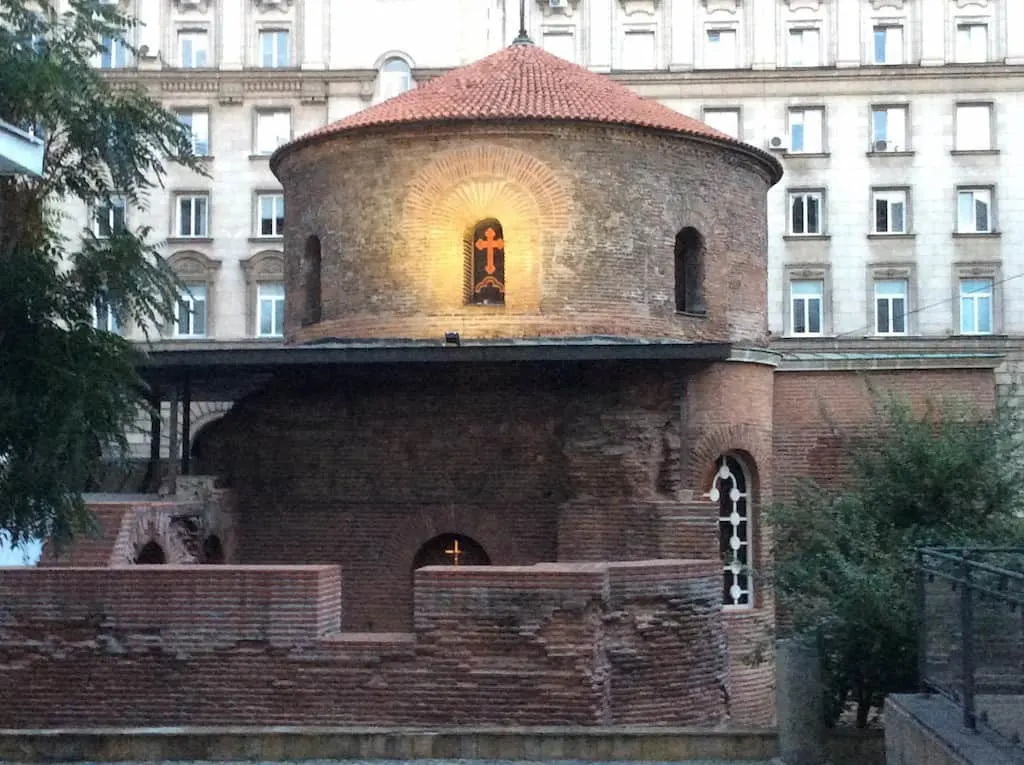
The structure is part of a larger ruins grouping from the 3rd and 4th century which includes a Roman street, a basilica and other buildings. Holy relics pertaining to St. Ivan Rilski, the patron saint of Bulgaria are kept here. When we visited, a joyful christening with several generations present was taking place.
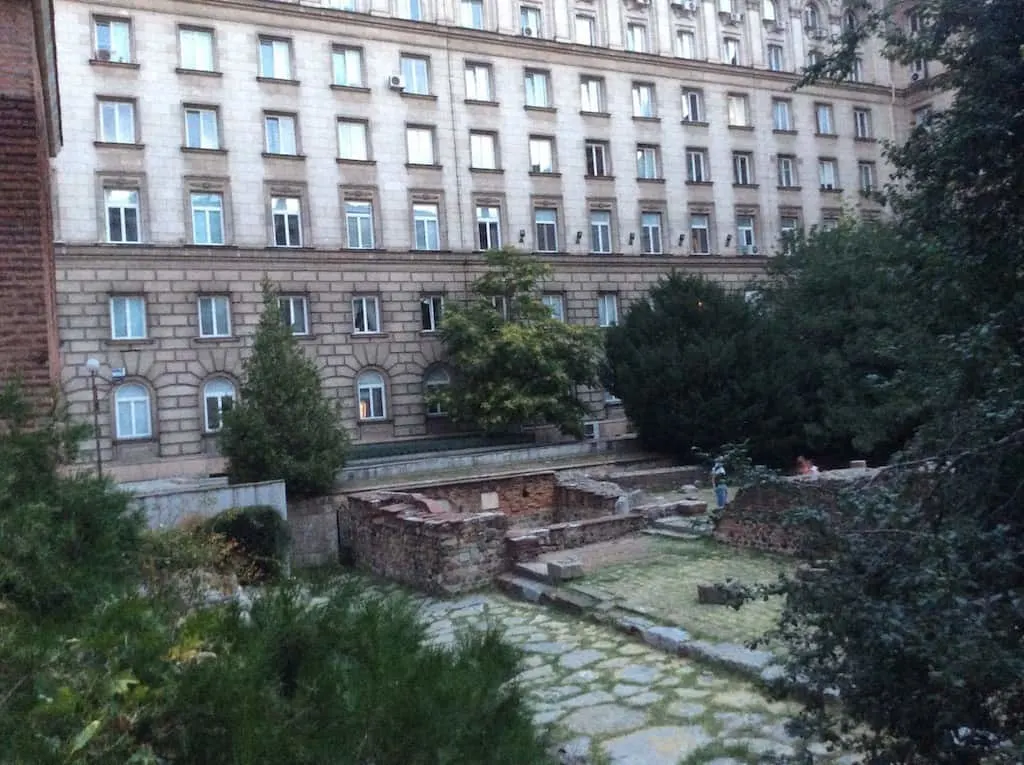
2. Sveta Nedelya Cathedral
Holy Sunday Church in Sofia is located in the true city centre, at the ancient Roman crossroads of Serdica.
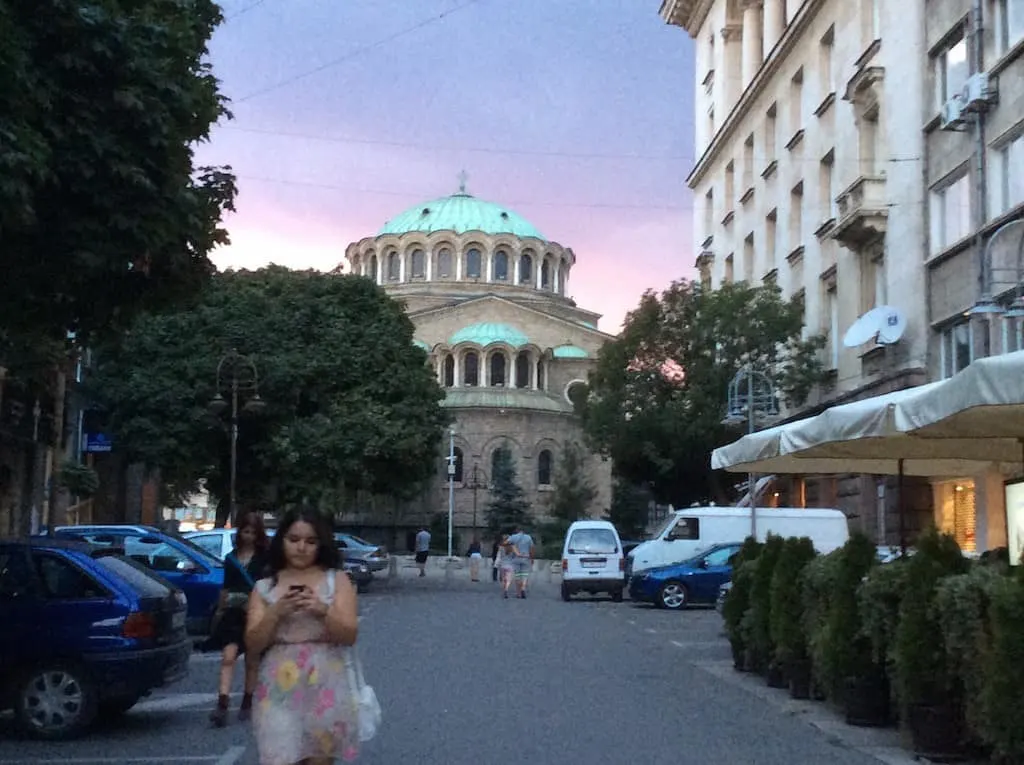
Originally a wooden structure built in the 10th century, Sveta Nedelya Cathedral was destroyed and/or demolished several times in its long history. Inaugurated as a large cathedral in the mid-19th century after a construction period of several years which was marred by an earthquake in 1858, its new domes were added in 1898.
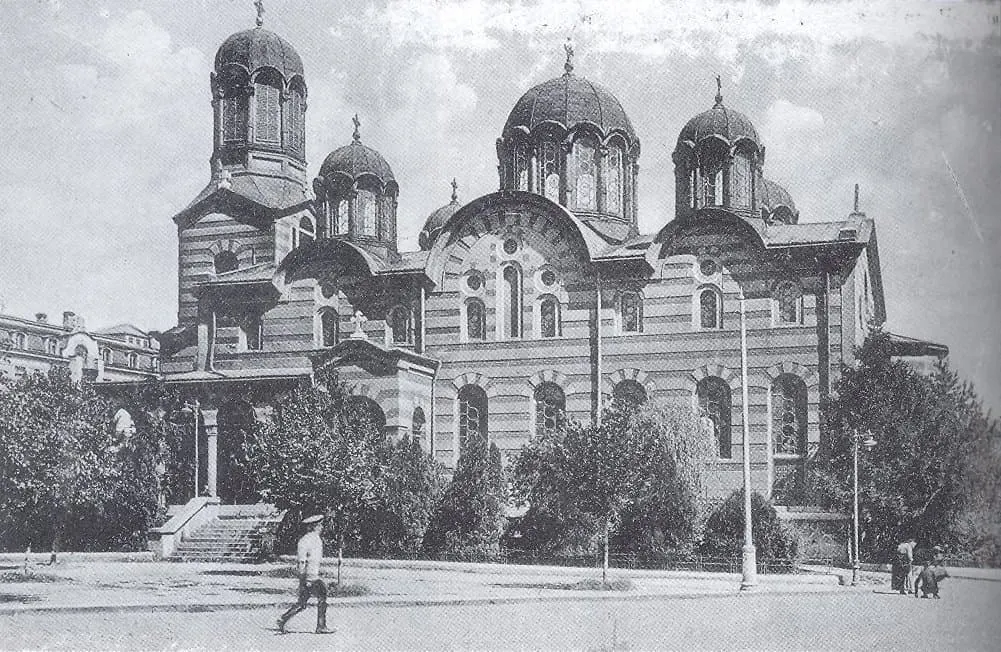
The Sveta Sofia church was completely demolished in 1925 after Bulgarian Communist Party terrorists detonated a bomb intended for Tsar Boris III there. The blast killed at least 150 people and injured another 500. This event resulted in a declaration of martial law and mass executions in retaliation. Relics of Serbian King Stephen Milutin, who ruled between 1282-1321 are housed in the church.
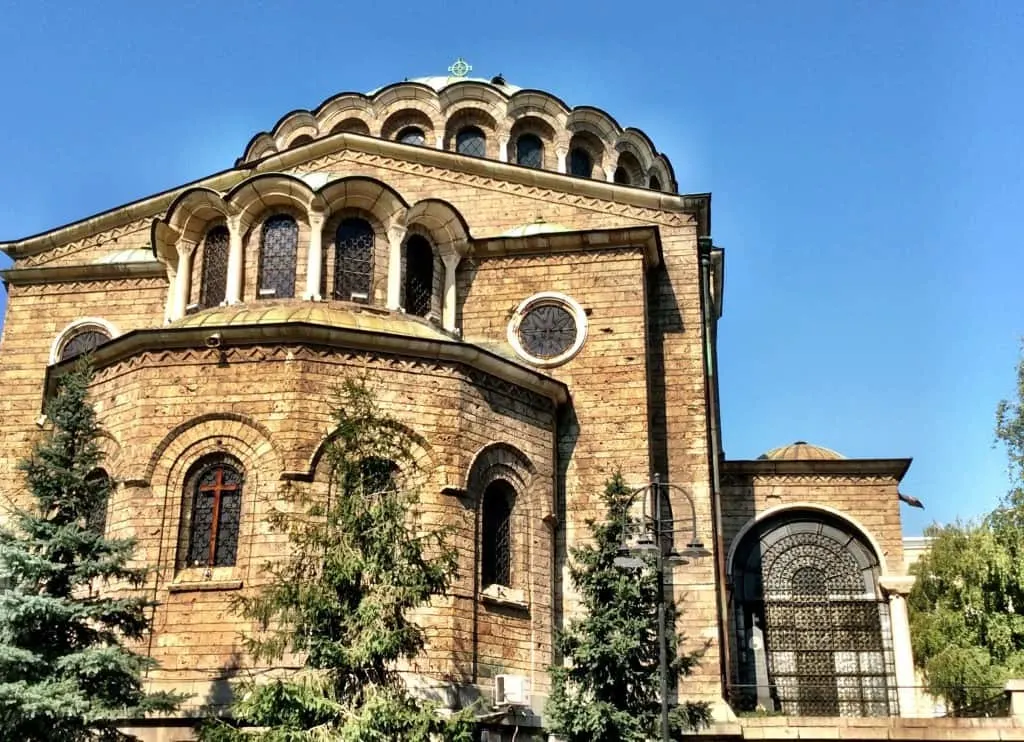
3. The Largo
Begun in 1954, this complex was built in what is known as the Socialist Classicist style, and is a short walk from the Sveta Nedelya church. The buildings themselves are surrounded by the remains of a historical Roman fortress which stood at the crossroads of Serdica. They, in turn, surround the St. George Rotunda Sofia, which is the centerpiece of their internal courtyard.
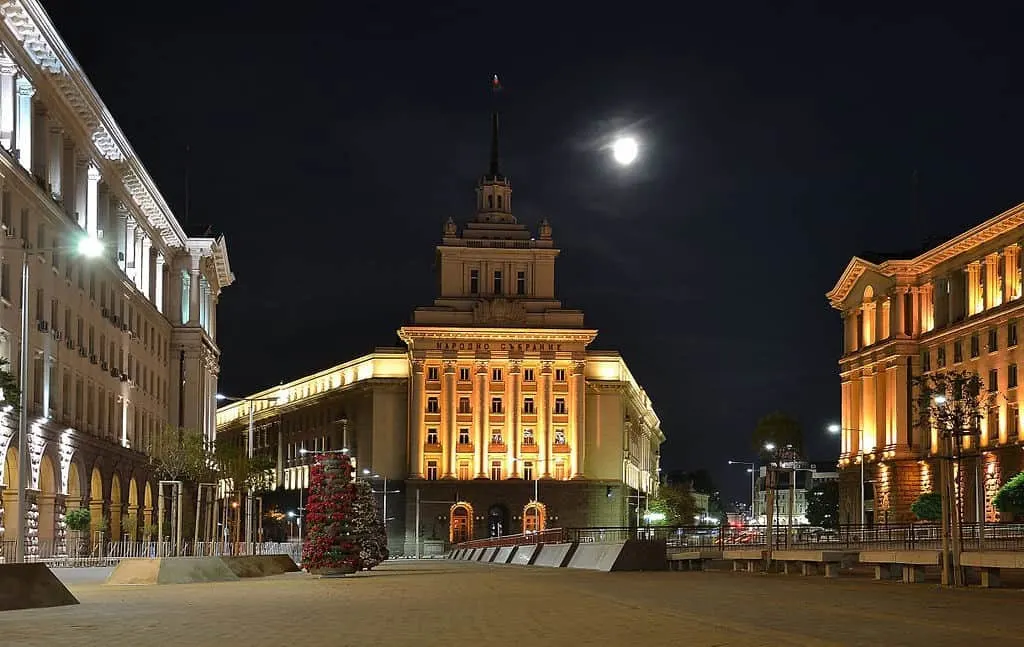
The original Bulgarian Communist Party House is now a National Assembly administrative center, flanked by an edifice that holds the TZUM department store and the Bulgarian Council of Ministers on one side, and another which houses the President’s Office, the Ministry of Education and the Hotel Balkan.
Many archeologists believe the Hotel Balkan is sited on the remains of a Roman palace which they attribute to Constantine the Great. The Hotel Balkan has hosted royals, heads of state and celebrities throughout its six decades of operation.
4. Serdica Ruins and Sveta Petka
Adjacent to the Largo are large excavations revealing Thracian and Roman ruins of the city of Serdica, which eventually will be viewed under glass. Two pedestrian underpasses connect as entrances to metro stations serving Nezavisimost (Independence Square).
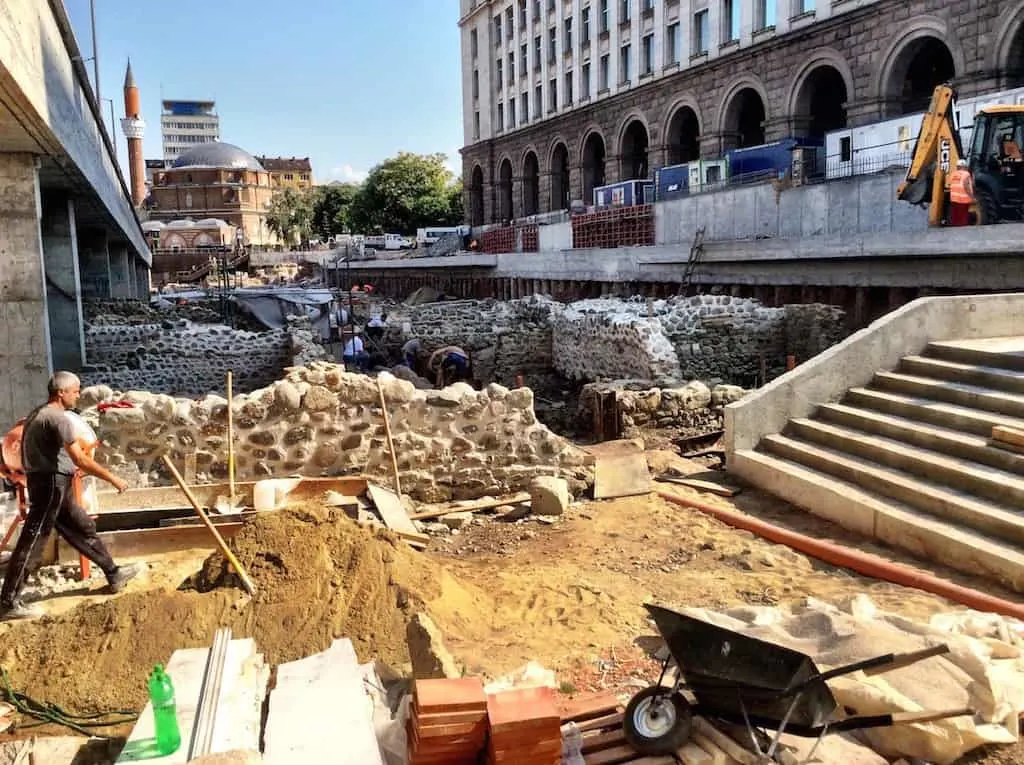
Sveta Petka Cathedral rises adjacent to the Largo and the excavations in one of the underpasses.
![Top 10 Best Things to Do in Sofia Bulgaria (2024) 10 Photo Credit: By Ann Wuyts [CC BY 2.0 (https://creativecommons.org/licenses/by/2.0)], via Wikimedia Commons](https://passingthru.com/wp-content/uploads/2016/04/1024px-Church_of_St_Petka_of_the_Saddlers-1024x683.jpg.webp)
Sveta Petka Cathedral is an Orthodox church that was built during the Ottoman occupation, half-buried so as not to exceed the height requirement of a soldier on horseback.

Sveta Petka church boasts interior frescoes and composite stone and brick walls over a meter thick. Named for a Bulgarian martyr from the 11th century, Petka Ikoniyska, the church was also the patron of Medieval saddlers.
5. Vitosha Street – Full of Things to Do in Sofia
Vitosha Boulevard is the main shopping street with some of the top restaurants in Sofia and exclusive Western stores. The atmosphere is stylish and lively, with a variety of cuisines and a promenade atmosphere, particularly vibrant in the summer with live music.
Sofia: Guided Street Art & Stunning Graffiti Walking Tour (new tour) Click here for details – Sofia’s urban art scene is vibrant and eclectic, as befitting the capital city of Bulgaria. Take advantage and scout out the pathways and artists on this guided walk with a knowledgable local.
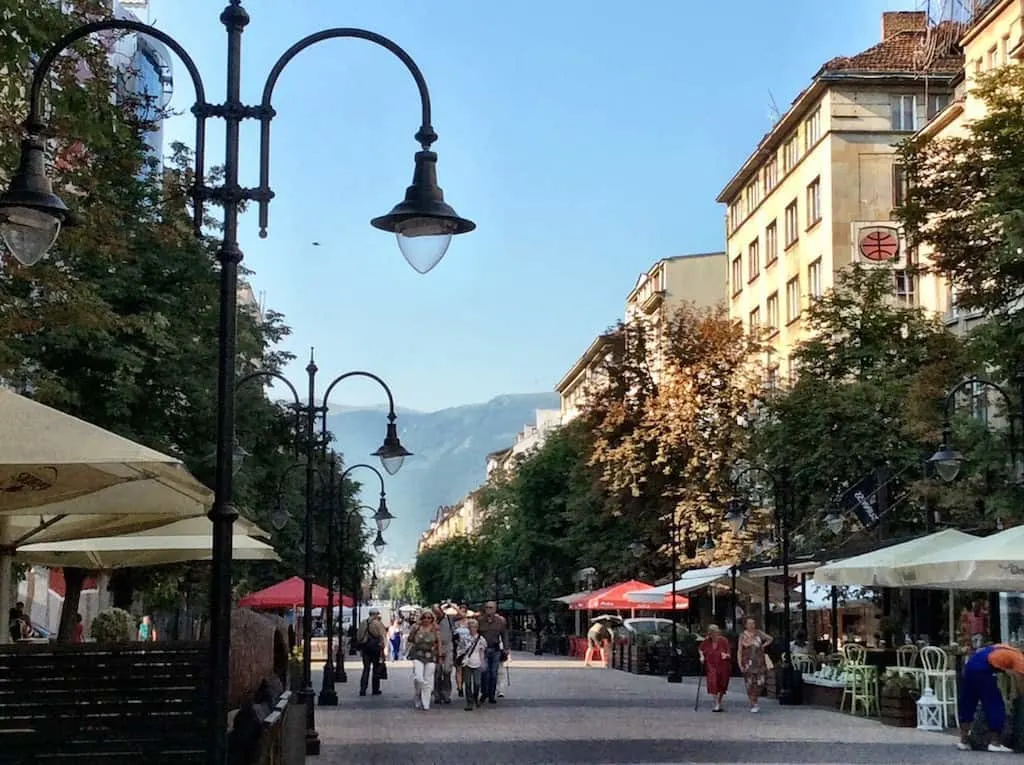
6. Central Synagogue Sofia Bulgaria
Constructed between 1904 and 1909 by an Austrian architect whose intention for the Sofia synagogue commission was to replicate the Sephardic synagogue in Vienna, the Bulgarian Sephardic synagogue is the 2nd largest synagogue in Europe (The biggest synagogue in Europe is the synagogue on Dohany street in Budapest). The building was partially destroyed, along with its Judaica library and Hebrew books, during the 1944 bombings.
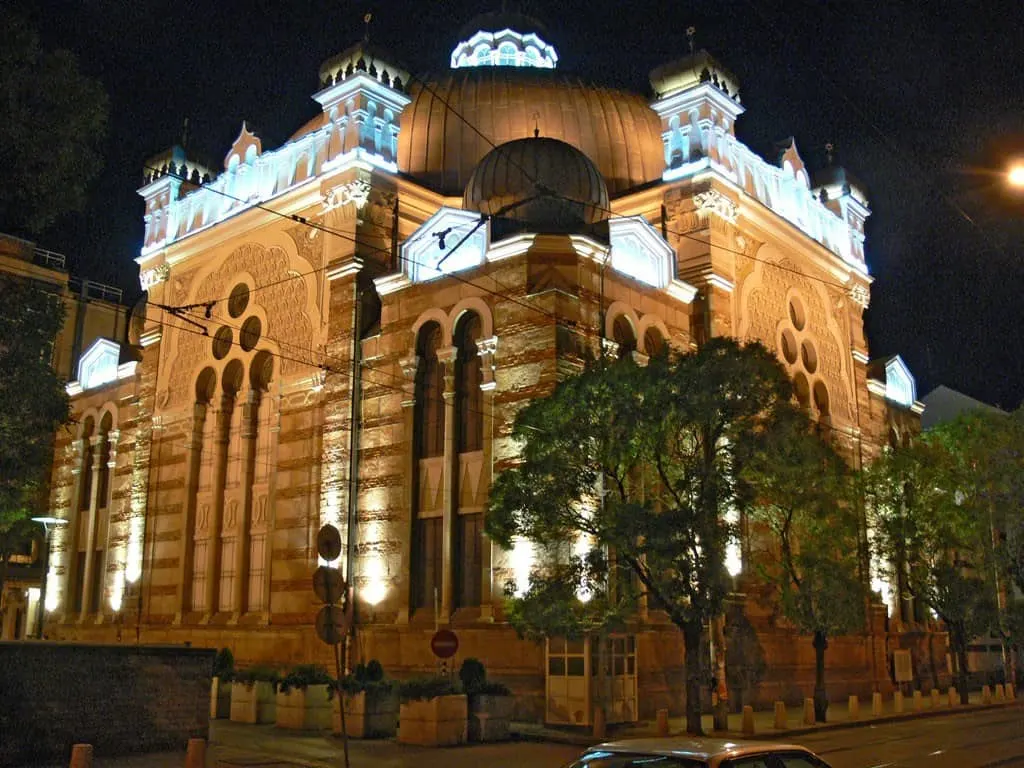
7. Sofia University Botanic Garden
Hidden in the city center within walking distance of the St Alexander Nevsky Church, you enter this garden through a flower shop to find an open garden and a glass conservatory. Over 1500 species are represented, and you can purchase saplings and seeds. This garden dates from 1892, with an inaugural oak, which was planted with a gold coin placed by Tsar Ferdinand in its roots, still standing. Open January – July and September – December. Nursery services include professional advice on plant care and aesthetics.
8. National Art Gallery (in the former royal palace of Bulgaria)
After the monarchy was abolished in 1946, the former royal palace of Bulgaria was converted into the National Art Gallery. The collection consists of contemporary art, National Revival art, and paintings from the Middle Ages, as well as 4,000 religious icons.
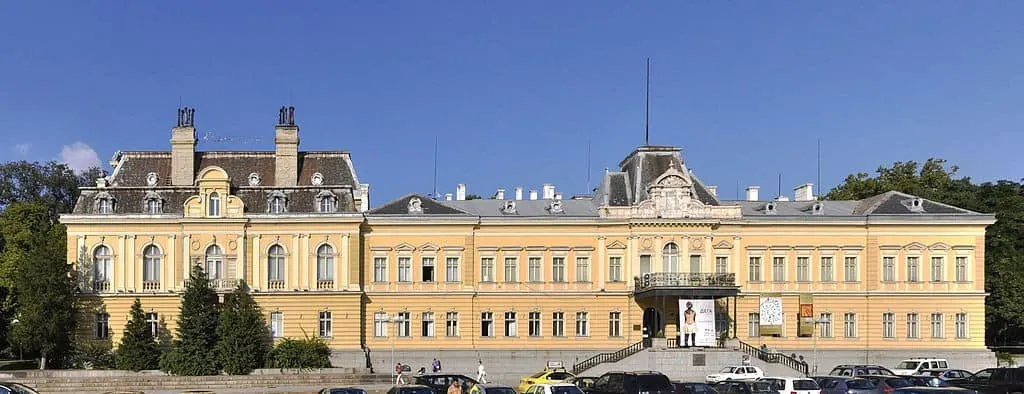
9. Borisova Gradina (Boris’ Garden)
Begun in 1884 and designed by three separate gardeners who developed the initial design, Boris’ Garden is named for Tsar Boris III. Borisova Gradina Park is the oldest, largest park in Sofia. By 1886, the city garden had four alleys in an area of 300,000 square meters. A large lake was added in 1889, along with deciduous and conifer trees. In the early 20th century, fountains, a playground, and a wealth of flowers and ornamentals made Borisova Gradina Park one of the largest parks in the Balkans. The garden was last reconstructed in 1986 and nature lovers will delight in its tranquil atmosphere.
![Top 10 Best Things to Do in Sofia Bulgaria (2024) 15 Borisova gradina lily pond in autumn. Photo Credit: By Gergana (Urbnastyle) [CC BY-SA 2.5 (https://creativecommons.org/licenses/by-sa/2.5)], via Wikimedia Commons](https://passingthru.com/wp-content/uploads/2016/04/Borisova_gradina_autumn.jpg.webp)
10. St Alexander Nevsky Cathedral
One of the largest Eastern Orthodox cathedrals in the world, the Neo-Byzantine style Russian church in Sofia was built to memorialize the quarter million Russian, Ukrainian, Belorussian and Bulgarian soldiers who died in the Russo-Turkish War of 1877-1878. Named for a sainted Russian prince and displaying Saint Alexander relics (including what may be a rib), it is over 34,000 square feet in size and can accommodate a congregation of 10,000.

There are a number of fun, interesting and inexpensive tours that cover many of the best places we listed above and more. And for a different historical approach, consider a Sofia pub crawl of hidden bars.
Best Day Trips from Sofia
One of the best ways to add to a city break would be to include one of these options in your Sofia itinerary:
From Sofia: Rila Monastery & Boyana Church Small Group Tour Click here for details – the Rita Monastery is the most important Orthodox cloister in Bulgaria, adorned with gilded balconies and frescoes. After lunch, visit the Byzantine Boyana Church, a UNESCO World Heritage Site. Travel in air conditioned van with English speaking guide. Click here for alternative option: transportation to the UNESCO sites with audio guide. Additional day trip options, including private transportation, click here.
Sofia: Lovech, Devetashka Cave, and Krushuna Waterfalls Tour (new tour) – The history and natural beauty of Bulgaria combine in this full day excursion with guide. Visit Lovech, a historic Ottoman city with fortress, Devetashka Cave (featured in the movie Expendables 2), and the Krushuna waterfalls, one of the largest in Bulgaria. Click here for details.
From Sofia: Plovdiv & Bachkovo Monastery 3-Day Guided Trip (new tour) – The city of Plovdiv is Bulgaria’s 2nd largest and dates back to Thracian times. Its Ottoman-era houses are situated on picturesque cobbled streets. Your tour will include a deep dive into Plovdiv’s architecture and culture, natural attractions such as waterfalls and mountain scenery in Bulgaria’s wine country, fortresses from medieval times and a monastery where Jews were hidden in WWII. Click here for details.
All too quickly, our stay in Bulgaria came to an end. We would have liked to visit more Sofia attractions, but sadly, ran out of time. We’re very much looking forward to returning to this beautiful, and very underrated, Balkan capital.
Where to Stay in Sofia
Sofia is probably the only capital city in Europe where you can live like a king in 5+ star comfort for less than the cost of a brand hotel off the interstate in the US. Sofia is probably the only capital city in Europe where you can live like a king in 5+ star comfort for less than the cost of a brand hotel off the interstate in the US. We found it to have the most affordable prices of all the European countries we visited.
The Sofia Hotel Balkan, where we stayed, rivals and surpasses 5-star properties in other European capitals. This is one of the best hotels in Sofia Bulgaria, if not all of Eastern Europe. Amenities include restaurant, bar, salon, business center. We had the best pedicures we’ve ever had, never to be forgotten. The Hotel Balkan’s spacious, luxurious interiors are beautifully finished and the service is impeccable.
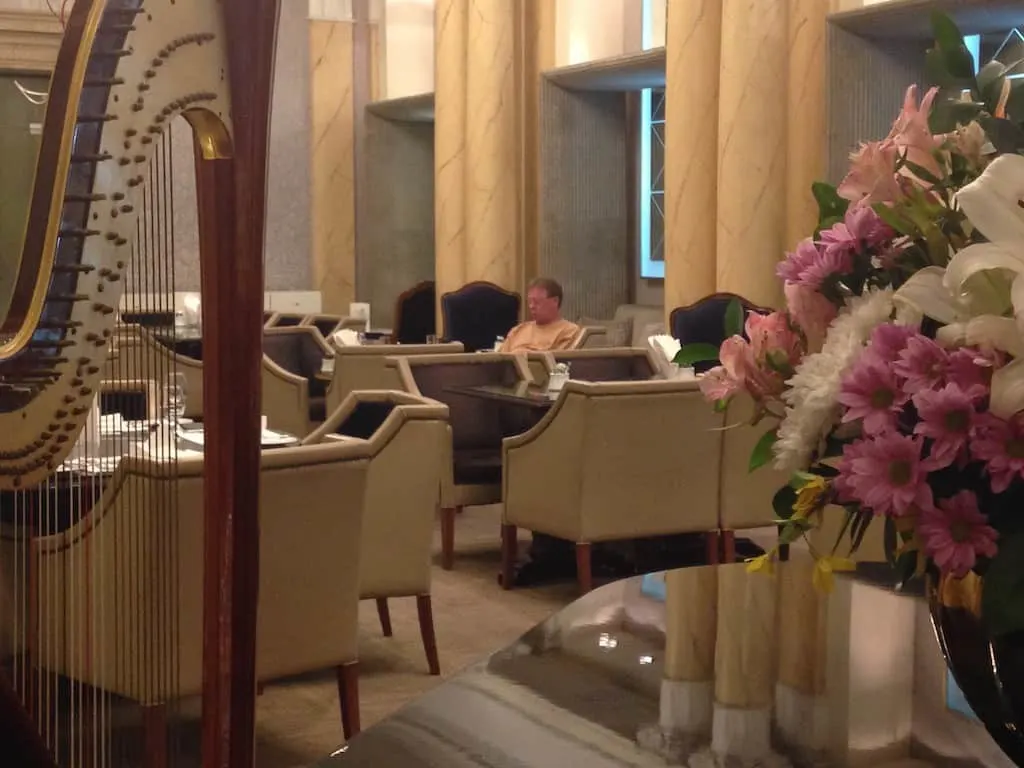
Where to Eat in Sofia
We ate several meals in sidewalk restaurants on Vitosha Street during our stay, but the evening we went down a leafy side street for traditional dishes that comprise Bulgarian cuisine at Moma Restaurant is one of the best restaurants in Sofia. Master chef Alexander Nikolov prepares eggplant-based and grilled meat dishes using vintage recipes, and then gives them a contemporary twist.

The setting is a striking combination of Bulgarian textiles and 20th-century modern seating, with enlargements of beautiful Bulgarian women in traditional dress. The building dates to the 1930s and there are three floors for indoor seating as well as a garden deck.
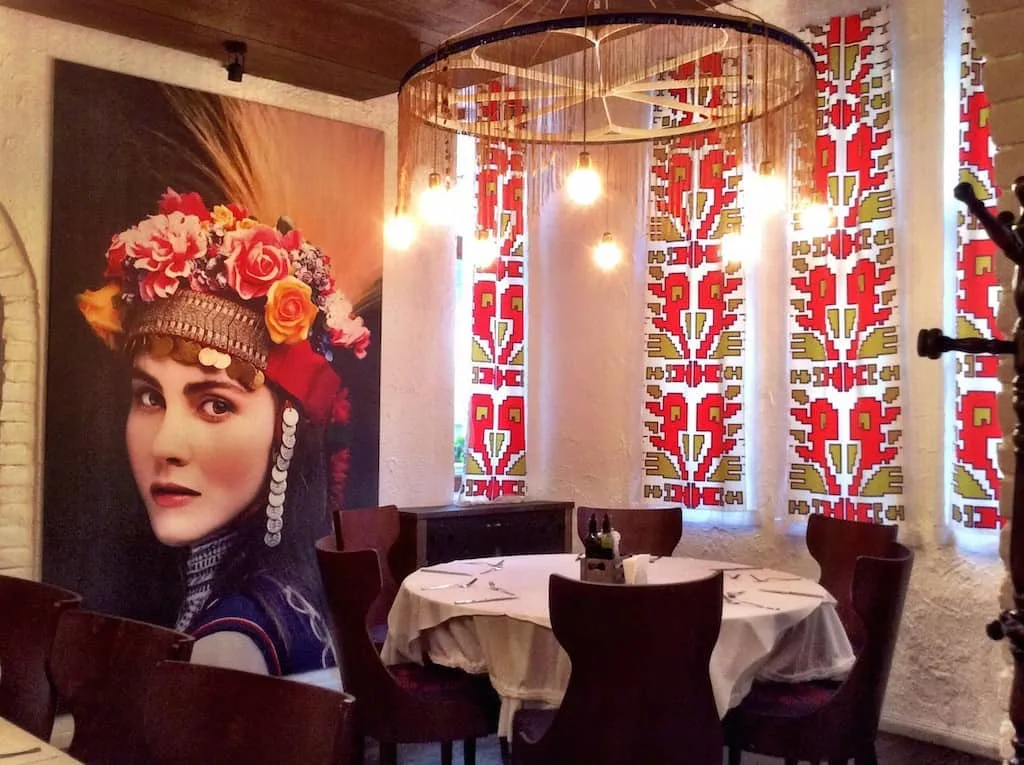
Pinnable Image:
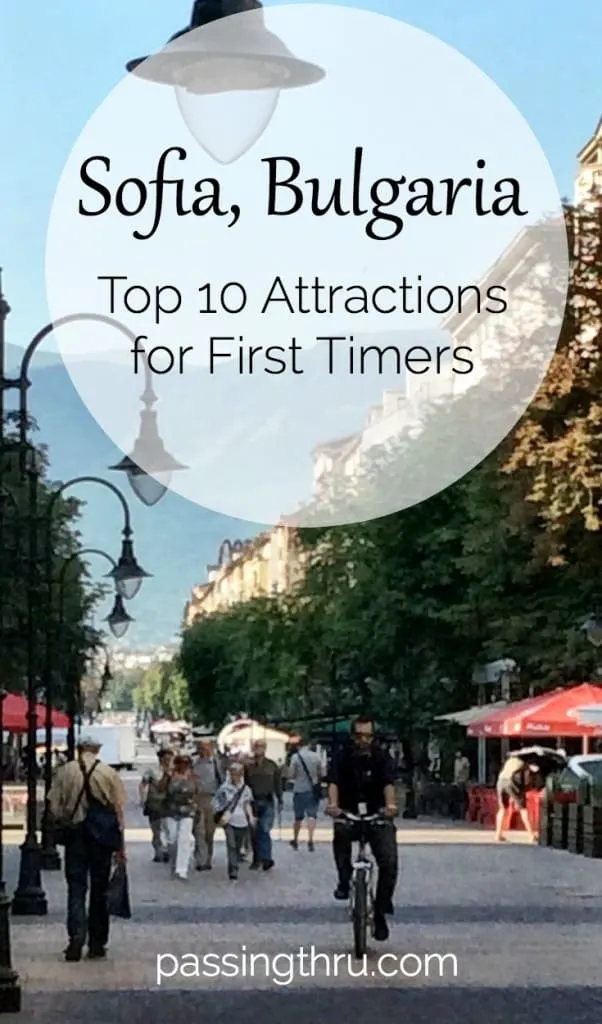
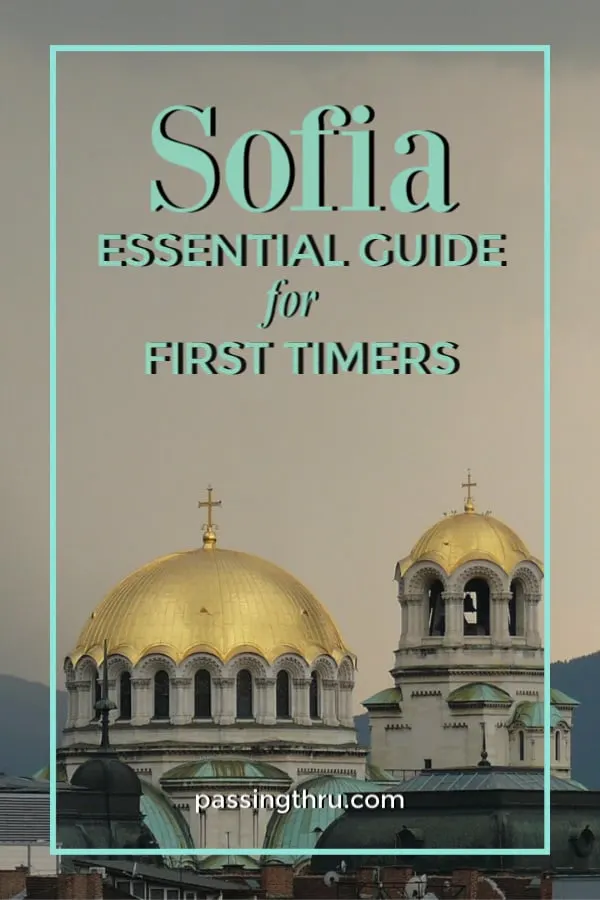
Tips for Trip Success
Book Your Flight
Find an inexpensive flight by using Kayak, a favorite of ours because it regularly returns less expensive flight options from a variety of airlines.
Book Your Hotel or Special Accommodation
We are big fans of Booking.com. We like their review system and photos. If we want to see more reviews and additional booking options, we go to Expedia.
You Need Travel Insurance!
Good travel insurance means having total peace of mind. Travel insurance protects you when your medical insurance often will not and better than what you get from your credit card. It will provide comprehensive coverage should you need medical treatment or return to the United States, compensation for trip interruption, baggage loss, and other situations.Find the Perfect Insurance Plan for Your Trip
PassingThru is a participant in the Amazon Services LLC Associates Program. As an Amazon Associate I earn from qualifying purchases.
To view PassingThru’s privacy policy, click here.

Lucy Ivan
Monday 3rd of January 2022
Really a very good post. You mentioned some of the best and most interesting things to do in Sofia (a local :) ) Thanks!
Bryony Clapperton (travelsandmore)
Sunday 9th of October 2016
This has really gotten me in the mood for my up and coming trip to Sofia. I'm a first timer so really looking forward to experiencing all these attractions and places. Eeeee exciting!
Sand In My Suitcase
Tuesday 23rd of August 2016
Are you serious? $60 night for a 5-star hotel! Wow! We're heading out on a Baltic cruise soon - and we're excited to be visiting European destinations we've not yet visited before, like St. Petersburg, Stockholm and Bergen. Now it looks like we'll have to plan a visit to Sofia (and Bulgaria) after that :-). Vitosha Street looks like a fun place to stroll and people-watch. And we'll keep the Sofia Hotel Balkan in mind!
Betsy Wuebker
Friday 26th of August 2016
Hi Janice - Yes, it's an amazing rate, isn't it? And it's not a temporary one, either. While I love the Baltic countries, I must admit the Balkan region is one I wouldn't hesitate to return to. Let us know how you get on!
Iván Fanego
Saturday 14th of May 2016
I lived in Sofia for 1 year (2007-2008 I think) and was an amazing place. You totally captured the essence of it, this is the places I took people when they visited me. Maybe you miss the St. Nicholas "the Miracle-Maker" church, it is a small but very cute place.
Enjoy the nomadic lifestyle!
Betsy Wuebker
Thursday 9th of June 2016
Hi Iván - Thank you so much!
Kristin Henning
Friday 6th of May 2016
We've been to Bali and stayed in Ubud, at a place owned by Tom's cousin. She and their friends try to maintain the best waulisty, '''https://www.vrbo.com/317703